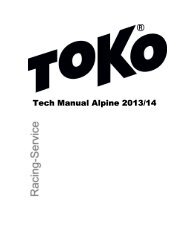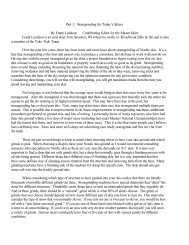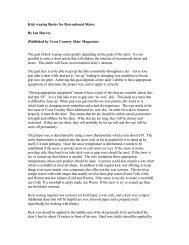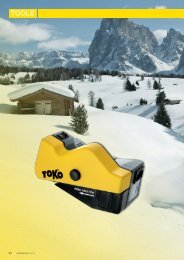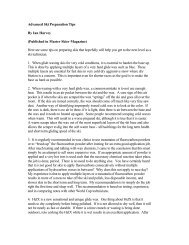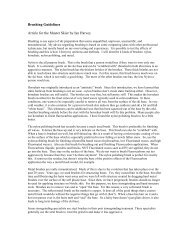Using the Toko Structurite By Ian Harvey There are two aspects to ...
Using the Toko Structurite By Ian Harvey There are two aspects to ...
Using the Toko Structurite By Ian Harvey There are two aspects to ...
Create successful ePaper yourself
Turn your PDF publications into a flip-book with our unique Google optimized e-Paper software.
<strong>Using</strong> <strong>the</strong> <strong>Toko</strong> <strong>Structurite</strong><br />
<strong>By</strong> <strong>Ian</strong> <strong>Harvey</strong><br />
<strong>There</strong> <strong>are</strong> <strong>two</strong> <strong>aspects</strong> <strong>to</strong> applying structure: <strong>the</strong> decision of what <strong>to</strong> apply and <strong>the</strong>n <strong>the</strong><br />
actual application of <strong>the</strong> structure. The second is <strong>the</strong> easy part. The first is <strong>the</strong> part that<br />
people tend <strong>to</strong> have problems with. I think <strong>the</strong> <strong>Toko</strong> <strong>Structurite</strong> <strong>to</strong>ol that came out in <strong>the</strong><br />
fall of 2009 will help a lot of people because it makes it easier <strong>to</strong> choose properly.<br />
Selection<br />
When selecting a structure, <strong>the</strong>re <strong>are</strong> four main fac<strong>to</strong>rs <strong>to</strong> consider. The four fac<strong>to</strong>rs <strong>are</strong><br />
moisture content of <strong>the</strong> snow, snow crystal type, dirt content of <strong>the</strong> snow, and how skied<br />
in <strong>the</strong> snow is going <strong>to</strong> be. Snow and air temperature <strong>are</strong> parameters that <strong>are</strong> much talked<br />
about. Mostly <strong>the</strong>se temperatures <strong>are</strong> considered so we know more about <strong>the</strong> moisture<br />
content of <strong>the</strong> snow.<br />
Obviously colder snow has less free moisture in it than warmer snow. When <strong>the</strong>re is less<br />
moisture in <strong>the</strong> snow, a finer structure is better. When <strong>the</strong>re is more moisture, more<br />
structure is better. Also, given <strong>the</strong> same amount of free moisture in <strong>the</strong> snow, when <strong>the</strong><br />
snow is transformed (corned up), more structure should be used. Conversely, <strong>the</strong> finer<br />
<strong>the</strong> snow, <strong>the</strong> less <strong>the</strong> structure required. If <strong>the</strong> snow contains dirt, sap, or pine needles, it<br />
is important <strong>to</strong> lean <strong>to</strong>ward less structure even if <strong>the</strong> snow contains a lot of moisture.<br />
This is because dirt tends <strong>to</strong> accumulate in <strong>the</strong> structure on <strong>the</strong> ski base creating friction.<br />
Lastly, <strong>the</strong> more skied in <strong>the</strong> snow will be, <strong>the</strong> more structure can be used. The less skied<br />
in, <strong>the</strong> less structure ought <strong>to</strong> be used. For this reason, it is important <strong>to</strong> consider if a race<br />
is a lap race where <strong>the</strong> snow gets very skied in or a course where <strong>the</strong> tracks get skied on<br />
only one time. Also in classic races of course <strong>the</strong> tracks get skied in far more than in<br />
skating races. For this reason, on average more structure is used in classic technique<br />
events than in skating.<br />
The fac<strong>to</strong>rs considered when choosing a glide wax <strong>are</strong> <strong>the</strong> same as those listed above.<br />
The colder and less moisture in <strong>the</strong> snow, <strong>the</strong> harder <strong>the</strong> wax should be (ie blue). The<br />
warmer and more moisture in <strong>the</strong> snow, <strong>the</strong> softer <strong>the</strong> wax should be (ie yellow). The<br />
more transformed <strong>the</strong> snow is, given <strong>the</strong> same temperature, <strong>the</strong> softer <strong>the</strong> wax. The finer<br />
<strong>the</strong> snow is, <strong>the</strong> harder <strong>the</strong> wax. When <strong>the</strong> snow is dirty, generally a harder wax is better<br />
as it contains less oil in it which picks up dirt. Additives like Molybdenum <strong>are</strong> also<br />
effective. Lastly, just like with structure, <strong>the</strong> more <strong>the</strong> course is going <strong>to</strong> get skied in, <strong>the</strong><br />
softer <strong>the</strong> glide wax should be. The less skied in it will get, <strong>the</strong> harder <strong>the</strong> glide wax can<br />
be.<br />
<strong>Toko</strong> has come up with three main structures that perform very well on average. One<br />
structure works very well in cold (blue glide wax) conditions. It is fine and linear.<br />
Ano<strong>the</strong>r works well in conditions below and up <strong>to</strong> freezing where red glide wax works.<br />
It is a pretty fine broken structure. When conditions <strong>are</strong> wet and a yellow glide wax is<br />
<strong>the</strong> call, we have a more aggressive broken structure that works well. These structures<br />
<strong>are</strong> named blue, red, and yellow corresponding <strong>to</strong> <strong>the</strong> waxes that <strong>the</strong>y compliment best.
If <strong>the</strong> wax used is appropriate, <strong>the</strong> structure of <strong>the</strong> same color ought <strong>to</strong> be really good as<br />
well.<br />
In extremely wet snow, sometimes a deep linear structure (a rill) is necessary. This is<br />
generally found when <strong>the</strong> snow is extremely wet such as found in <strong>the</strong> late spring or when<br />
it is raining. The yellow <strong>Toko</strong> <strong>Structurite</strong> pattern is not aggressive enough by itself for<br />
this very wet snow. A rill (2mm perhaps) can be applied over <strong>the</strong> yellow structure. In<br />
less extreme warm conditions though, <strong>the</strong> yellow structure is very good. It is also good<br />
where <strong>the</strong>re is dirt and it is wet as it is not as aggressive.<br />
Application<br />
Put <strong>the</strong> appropriate structure bit in <strong>the</strong> <strong>to</strong>ol. Slide <strong>the</strong> <strong>to</strong>ol over <strong>the</strong> tip of <strong>the</strong> ski, press<br />
down, and while keeping maximum pressure, push <strong>the</strong> <strong>to</strong>ol down <strong>the</strong> length of <strong>the</strong> ski all<br />
<strong>the</strong> way <strong>to</strong> <strong>the</strong> tail. Try <strong>to</strong> keep strong downward pressure on <strong>the</strong> <strong>to</strong>ol <strong>the</strong> entire time.<br />
Also, be c<strong>are</strong>ful <strong>to</strong> weight <strong>the</strong> entire <strong>to</strong>ol, not just one side of it. Should one side get more<br />
pressure than <strong>the</strong> o<strong>the</strong>r, <strong>the</strong> side with less pressure will have less structure applied. One<br />
solid pass should be enough. If <strong>the</strong> pass was not good for some reason (not enough<br />
pressure or uneven pressure), <strong>the</strong>n reapply with one more good pass.<br />
Most commonly, structure is applied after <strong>the</strong> HF layer is scraped and brushed out as<br />
ironing reduces structure on <strong>the</strong> ski base. For example, if I were waxing with LF Moly<br />
followed by HF Red covered by JetStream Red, I’d apply my Red structure after ironing,<br />
scraping, and brushing out my HF Red. Were I <strong>to</strong> apply <strong>the</strong> structure before applying <strong>the</strong><br />
HF Red, it would make it smoo<strong>the</strong>r and less aggressive. This is done r<strong>are</strong>ly. Structure<br />
can also be applied at <strong>the</strong> start over <strong>the</strong> race wax if necessary. When I do this, I prefer <strong>to</strong><br />
brush out <strong>the</strong> structure (nylon polishing or horsehair) and <strong>the</strong>n lightly rub on and polish<br />
<strong>the</strong> fluorocarbon of <strong>the</strong> day (JetStream for example) over <strong>the</strong> applied structure <strong>to</strong> “finish<br />
it”, but this is not absolutely necessary.<br />
O<strong>the</strong>r considerations<br />
Sometimes we end up using a harder or “colder” glide wax than one would think. This is<br />
probably because relative <strong>to</strong> <strong>the</strong> temperature, <strong>the</strong> snow contains less moisture and/or is<br />
finer than one would have expected. Also, this is often <strong>the</strong> case in one lap or point <strong>to</strong><br />
point skating races where <strong>the</strong> snow isn’t going <strong>to</strong> become very skied in. In this situation,<br />
<strong>the</strong> colder structure should also be used. Generally, it never happens that a coarse<br />
structure with a cold wax or a very fine (cold snow) structure with a wax for warm<br />
conditions works better than having <strong>the</strong>m matched up and appropriate for <strong>the</strong> conditions.<br />
That’s just not how snow is. Bizarrely, on occasion it might be not <strong>to</strong>o bad, but it won’t<br />
be as good as having <strong>the</strong> correct wax and structure.<br />
I recommend starting with a “cold” or “cold universal” s<strong>to</strong>negrind and <strong>the</strong>n managing <strong>the</strong><br />
skis by using hand structure. Should a ski have a lot of structure on it, even <strong>to</strong>o much for<br />
<strong>the</strong> conditions of <strong>the</strong> day, it doesn’t do much good <strong>to</strong> apply a “colder” structure over it.<br />
For this reason, it is best <strong>to</strong> have a fine structure on <strong>the</strong> skis and add structure as needed.



